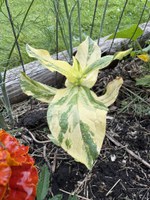Dakota Gardener: Plant variegation
(Click an image below to view a high-resolution image that can be downloaded)
By Carrie Knutson, Horticulture agent
NDSU Extension – Grand Forks County
I love zinnias. They are one of my favorite flowers. I interplant long rows of zinnias with my pumpkin and squash plants every year. Last year, as I was weeding the rows, I noticed a plant that had a striking difference from the rest. The plant was variegated. It had green leaves with strips of light-green and cream colors. Not missing the chance to experiment, I marked the plant, and last fall saved the seed separately. I started the seeds this spring.
Before we talk about the results of my experiment, let’s discuss plant variegation. According to the Merriam-Webster Dictionary, variegation means a diversity of colors. For plants, these differences can be in colors, in the leaves or in the flowers. The variegation results in different patterns of contrasting colors.
In the landscape, there are many plants that have variegated leaf varieties, for example, dogwoods, hostas and grasses. Variegated plants add texture and color to our gardens and create focal points. The contrasting colors can brighten darker areas.
Variegation in house plants is just as popular as in the landscape. Variegated plants like philodendrons, pothos and monstera are popular. Sometimes, variegated varieties can be more expensive as they can be harder to commercially produce.
What is variegation? Let’s start with why plant tissue is green. Plant tissue is green because it contains chlorophyll. Chlorophyll is a green pigment that plants use to produce their own food through the process of photosynthesis. This means that white leaf tissue doesn’t produce any food for the plant. The rest of the plant has to work harder to produce enough food for the whole plant. As a result, variegated plants can be less robust than their green counterparts.
Variegation can occur naturally by a mutation in a plant’s genetics. Mutations can be caused by changes in the environment or by viruses. Sometimes these changes are stable and can be selected and grown by seed. Other times, the changes are the result of a change in the cells in a region of growth (leaf tips, for example). To keep the variegation, the plant must be propagated through cuttings.
Would my saved zinnia seeds have the same variegation? Because zinnias are cross-pollinated, I was unsure if the change would be passed through the seed.
It turns out that variegation can be passed through the seed. I only had one seedling survive. I planted it in my yard where I could give it extra attention. I hope I get to save seeds from it this year. Happy gardening!
NDSU Agriculture Communication – July 23, 2025
Source: Carrie Knutson, 701-780-8229, carrie.knutson@ndsu.edu
Editor: Kelli Anderson, 701-231-6136, kelli.c.anderson@ndsu.edu




